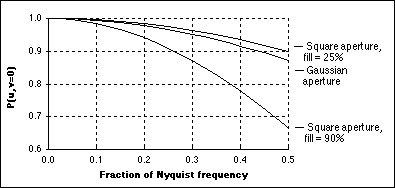








To prevent the possible aliasing (overlapping) of spectral terms that is inherent in eq. two conditions must hold:
* Bandlimited A(u,v) -

* Nyquist sampling frequency -

where uc and vc are the cutoff frequencies in the x and y direction, respectively. Images that are acquired through lenses that are circularly-symmetric, aberration-free, and diffraction-limited will, in general, be bandlimited. The lens acts as a lowpass filter with a cutoff frequency in the frequency domain (eq. ) given by:

where NA is the numerical aperture of the lens and  is
the shortest wavelength of light used with the lens . If the lens does not meet
one or more of these assumptions then it will still be bandlimited but at lower
cutoff frequencies than those given in eq. . When working with the F-number
(F) of the optics instead of the NA and in air (with index
of refraction = 1.0), eq. becomes:
is
the shortest wavelength of light used with the lens . If the lens does not meet
one or more of these assumptions then it will still be bandlimited but at lower
cutoff frequencies than those given in eq. . When working with the F-number
(F) of the optics instead of the NA and in air (with index
of refraction = 1.0), eq. becomes:

The spectra are evaluated along one axis of the 2D Fourier transform. The
Gaussian aperture in Figure 16 has a width such that the sampling interval
Xo contains +/-3 (99.7%) of the Gaussian. The
rectangular apertures have a width such that one occupies 95% of the sampling
interval and the other occupies 50% of the sampling interval. The 95% width
translates to a fill factor of 90% and the 50% width to a
fill factor of 25%. The fill factor is discussed in
Section 7.5.2.
(99.7%) of the Gaussian. The
rectangular apertures have a width such that one occupies 95% of the sampling
interval and the other occupies 50% of the sampling interval. The 95% width
translates to a fill factor of 90% and the 50% width to a
fill factor of 25%. The fill factor is discussed in
Section 7.5.2.

